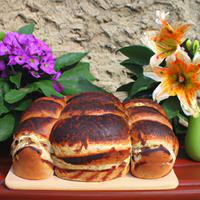
1 serving (50 grams) contains 125 calories, 4.0 grams of protein, 1.5 grams of fat, and 25.0 grams of carbohydrates.

Log this food in SnapCalorie

Nutrition Information
Calories |
625 | ||
|---|---|---|---|
% Daily Value* |
|||
| Total Fat | 7.5 g | 9% | |
| Saturated Fat | 1.2 g | 6% | |
| Polyunsaturated Fat | 0 g | ||
| Cholesterol | 0 mg | 0% | |
| Sodium | 1000 mg | 43% | |
| Total Carbohydrates | 125 g | 45% | |
| Dietary Fiber | 5 g | 17% | |
| Sugars | 5 g | ||
| protein | 20 g | 40% | |
| Vitamin D | 0 mcg | 0% | |
| Calcium | 50 mg | 3% | |
| Iron | 3.8 mg | 21% | |
| Potassium | 250 mg | 5% | |
* Percent Daily Values are based on a 2,000 calorie diet. Your daily values may be higher or lower depending on your calorie needs.
Food Attributes
Source of Calories
About Tiger bloomer bread
Tiger Bloomer Bread is a flavorful loaf known for its crackled crust and soft, airy interior. Originating from the Netherlands, where it’s called "tijgerbrood," its unique pattern is created by brushing a rice flour paste over the dough before baking. Typically made from basic ingredients like wheat flour, yeast, water, salt, sugar, and rice flour, it’s a versatile bread enjoyed across European cuisine. Rich in carbohydrates, it provides energy, but it’s not a significant source of fiber, vitamins, or minerals. Depending on preparation, it may contain added sugars and sodium, which can be a consideration for certain diets. Tiger Bloomer Bread is best eaten in moderation as part of a balanced diet, and works wonderfully for sandwiches or paired with soups, allowing its crunchy crust and delicate taste to shine.



